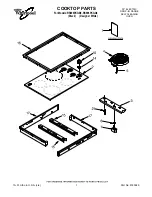
15
6. Remove the residual water and loosened soils with a sponge
or cloth immediately after the Clean cycle is complete. Much
of the initial 1
3
/
4
cups (14 oz [414 mL]) of water will remain
in the oven after the cycle is completed. If additional soils
remain, leave a small amount of water in the oven bottom
to assist with the cleaning.
7. If any soils remain, remove them with a non-scratch scrubbing
sponge or plastic scraper. Additional Clean cycles may be run
to help remove the stubborn soils.
IMPORTANT: Do not use oven cleaners. The use of chemicals,
including commercial oven cleaners or metal scouring pads,
may cause permanent damage to the porcelain surface of the
oven interior.
NOTES:
■
The range should be level to ensure that the entire surface
of the bottom of the oven cavity is covered by water at the
beginning of the Clean cycle.
■
For best results, use distilled or filtered water. Tap water
may leave mineral deposits on the oven bottom.
■
Before removing the residual water and loosened soils at the
end of the Clean cycle, insert a cloth or paper towel between
the lower edge of the oven door and the front frame to keep
water from spilling onto the front of the range and the floor.
■
Soil baked on through several cooking cycles will be more
difficult to remove with the Clean cycle.
■
Nonabrasive scrub sponges or eraser-style cleaning pads
(without cleaners) can be effective for cleaning the oven cavity
walls, oven door, and oven bottom for difficult soils. For best
results, moisten the pads and sponges before use.
■
Run an additional Clean cycle for stubborn soils.
■
affresh
®
Kitchen Appliance Cleaner and affresh
®
Cooktop
Cleaner may be used to clean the oven bottom, walls, and
door when the oven has finished the cycle and returned to
room temperature. If affresh
®
Cooktop Cleaner is used, it
is recommended to wipe out the cavity with distilled water
as well. Refer to the “Accessories” section for information
on ordering.
■
Additional AquaLift
®
Technology Cleaning Kits may be
obtained by ordering Part Number W10423113RP. See
the “Accessories” section for more information.
■
For assistance with AquaLift
®
Technology, call 1-877-258-0808
in the U.S.A. or 1-800-807-6777 in Canada, or visit our website
at
http://whirlpoolcorp.com/aqualift.
General Cleaning
IMPORTANT: Before cleaning, make sure all controls are off and
the oven and cooktop are cool. Always follow label instructions
on cleaning products. For additional information, you can visit our
website at
www.whirlpool.com.
Soap, water, and a soft cloth or sponge are suggested first unless
otherwise noted.
EXTERIOR PORCELAIN ENAMEL SURFACES
(on some models)
Food spills containing acids, such as vinegar and tomato, should
be cleaned as soon as the entire range is cool. These spills may
affect the finish.
Cleaning Method:
■
Glass cleaner, mild liquid cleaner, or nonabrasive
scrubbing pad:
Gently clean around the model/serial/rating plate
because scrubbing may remove numbers.
■
affresh
®
Kitchen and Appliance Cleaner Part Number
W10355010 (not included):
See the “Accessories” section for more information.
STAINLESS STEEL (on some models)
NOTE: To avoid damage to stainless steel surfaces, do not use
soap-filled scouring pads, abrasive cleaners, Cooktop Cleaner,
steel-wool pads, gritty washcloths, or abrasive paper towels.
Damage may occur to stainless steel surfaces, even with one-time
or limited use.
Cleaning Method:
Rub in direction of grain to avoid damaging.
■
affresh
®
Stainless Steel Cleaner Part Number W10355016
(not included):
See the “Accessories” section for more information.
METALLIC PAINT (on some models)
Do not use abrasive cleaners, cleaners with bleach, rust removers,
ammonia, or sodium hydroxide (lye) because the paint surface
may stain.
CERAMIC GLASS (on some models)
To avoid damaging the cooktop, do not use steel wool, abrasive
powder cleansers, chlorine bleach, rust remover, or ammonia.
1. Remove food/residue with the Cooktop Scraper.
■
For best results, use the Cooktop Scraper while the
cooktop is still warm but not hot to the touch. It is
recommended to wear an oven mitt while scraping
the warm cooktop.
■
Hold the Cooktop Scraper at approximately a 45° angle
against the glass surface and scrape the residue. It will
be necessary to apply pressure in order to remove the
residue.
Allow the cooktop to cool down completely before proceeding
to Step 2.
Summary of Contents for WFE775H0HZ1
Page 44: ...67 NOTA ...
















































